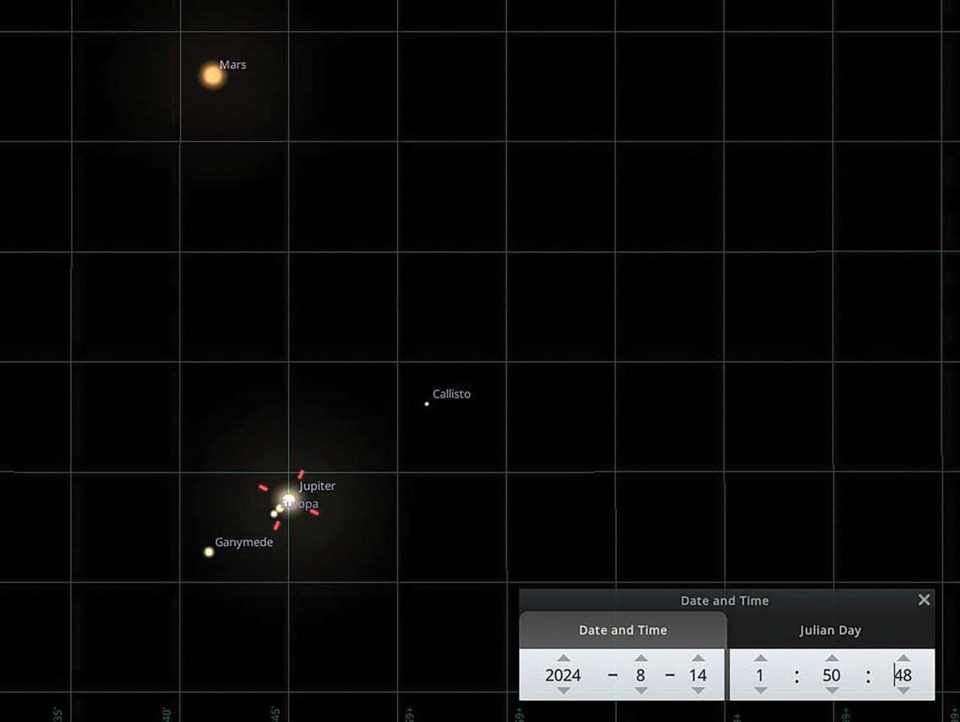If it’s August, it’s time for the Perseid meteor shower. This is one of the most popular and well-known meteor showers, mainly, I think, because it occurs in the summer and it has one of the higher Zenithal Hourly Rates (ZHR) of the known streams. The Observer’s Handbook from the Royal Astronomical Society of Canada (RASC) gives this as 90 per hour with the peak around Aug. 12 at 07:00 our time––in daylight, unfortunately. However, it’s usually pretty good for at least a couple of days on either side. The meteors will appear to radiate from a point in Perseus, a constellation high in the NE after 10:00 in the evenings.
The source of these meteors is Comet Swift–Tuttle which, according to NASA “was discovered in 1862 by Lewis Swift and Horace Tuttle. Swift-Tuttle is a large comet: its nucleus is 16 miles (26 kilometres) across. (This is almost twice the size of the object hypothesized to have led to the demise of the dinosaurs.)” It makes me very happy to know that we’re only likely to run into the little bits of debris shed by the comet in its looping orbits around the sun and not the comet itself. Apparently, Giovanni Schiaparelli deduced in 1865 that this comet was the source of the Perseids. And, yes, that got a crater on Mars named after him, the one that Matt Damon had to drive his jury-rigged rover to in order to catch a return ride to Earth in the movie The Martian. Comet Swift-Tuttle last visited the inner solar system in 1992 in its 133-year orbit and I’ve also read that the gradual spreading of the debris stream, as well as gravitational perturbation effects of Jupiter mean that the intensity of the showers seems to decrease after each perihelion pass. It’s still a lovely sight at its best and for this August, the best viewing will be after moonset, which occurs about 22:35 on Aug. 10 to 00:20 on Aug. 14. Pick a comfortable spot, park bench or chaise longue with a good view of the sky and just look up. No viewing aids needed.
The site www.spaceweather.com shows noctilucent cloud appearances, aurora predictions and a daily update on the T Corona Borealis nova expected in the next few months. That star has been about magnitude 10.4 to 10.2 but recently went to 10.1 but that may be just noise because when it flares it will brighten to magnitude 2 or so. We’ll just have to wait and see. Literally.
I was also reminded it was just over 55 years ago––the evening of July 20, 1969, in North America––when Neil Armstrong and Buzz Aldrin stepped out of the Eagle Lunar Module and took one giant leap for mankind. Every time I get the moon in the eyepiece(s) I think of that piece of history. I may still have the front page of the next day’s Calgary Herald with the headline.
As we round the sun, more of the planets are becoming visible and this month has three notable conjunctions. First, on Aug. 13 at 23:00, the moon will be about 0.5 degrees S of Antares, the bright star in Scorpio, low in the SW. Next, about three hours later, on Aug. 14 at 01:35, Mars and Jupiter are only 0.3 degrees apart rising low in the ENE. With binoculars that show Jupiter’s moons, you’ll be able to see Mars as a small red disc in the same field of view just above Jupiter, as the attached screenshot shows. Finally, the moon and saturn make a close pass on Aug. 20 at about 22:00 when the moon will be about 1.5 degrees E of Saturn. With a small scope you’ll also be able to see Titan, Saturn’s big moon, about five minutes above and right of Saturn (that’s about one sixth the width of the moon). We’re too far north to see it and far enough west that the Earth blocks it but those in North Africa and parts of South America would see the moon occult Saturn at about 19:00 our time. For reference, an Aspirin pill or your little fingernail at arms-length are both about half a degree wide or 30 minutes of arc. That’s almost exactly the same angular size as our moon and also the sun.
The SCAC monthly meetings will resume in September and will likely be held at the Sechelt Seniors Activity Centre, depending on repair progress at the Sechelt Library. Details for the next meeting and ongoing observatory openings should be available on the club website at: https://sunshinecoastastronomy.wordpress.com/





